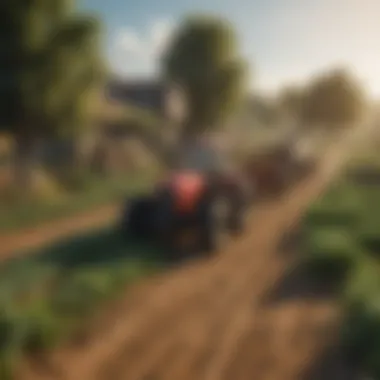Exploring Farm Games Apps: A Detailed Overview


Intro
The world of farm games apps has truly blossomed over the past decade. These games transport players to picturesque landscapes where sowing seeds, tending to crops, and raising animals have become a daily digital delight. As the mobile gaming landscape evolves, farm games have carved out a niche, appealing not only to casual gamers but also to those who spend hours perfecting their virtual farms. This article will explore the nuances of farm gaming, from gameplay mechanics to community impact, providing a thorough look into this captivating genre.
Overview of the Game
Game Title
Stardew Valley
Release Date
February 26, 2016
Developer
ConcernedApe
Genre
Simulation, Role-Playing
Stardew Valley stands out as a prime example within the farm game genre. It introduced many gamers to the charming simplicity that defines farm simulation games while weaving deeper mechanics into its narrative structure. Players step into the role of a character who inherits a run-down farm, and from there, the adventure unfolds as they cultivate crops, engage with the local community, and explore various paths to success.
Gameplay Review
Graphics Quality
The pixel art style of Stardew Valley gives it a unique charm that resonates with players of all ages. The colors are vibrant, and the animations are fluid, providing an engaging visual experience. Every season brings new aesthetic changes, adding freshness to the pixelated world that captivates players.
Controls
Controls are intuitive, allowing players to quickly understand how to plant, harvest, and interact with the game world. On mobile devices, touch controls facilitate an effortless experience, making farm management feel seamless.
Mechanics
At its core, Stardew Valley employs a well-balanced mix of crafting, farming, and exploration mechanics. Players manage their time to maximize efficiency while choosing which crops to plant based upon seasonal availability. The importance of relationships also weaves into the gameplay, as engaging with villagers can lead to beneficial rewards and events.
In-Game Features
Some noteworthy features include:
- Seasonal Changes: Each in-game season alters available crops and events.
- Fishing and Mining: Diversifies gameplay beyond farming.
- Community Center: Encourages players to complete bundles to restore the local town.
Storyline Analysis
Plot Summary
The narrative invites players to become part of a bustling community, where they can shape their farm’s legacy while navigating the lives of various townsfolk. The overarching quest to renovate the community center gives players a goal that goes beyond farming, creating an engaging story arc.
Characters
A captivating aspect is the array of characters players can meet. From romantic interests to quirky locals, each character has a backstory that provides emotional depth and encourages players to invest time and effort into forming relationships.
Pacing
Pacing in Stardew Valley feels natural, allowing players to progress at their own speed while gradually unearthing the game’s hidden gems, thus widening their gameplay experience.
Narrative Depth
The story transcends mere farming; it incorporates themes of community, personal growth, and harmony with nature. These layers add a richness that appeals to both casual players and those seeking a more involved narrative.
Community Impact
Popularity Trends
Since its release, Stardew Valley has witnessed a surge in popularity, especially within the indie gaming community. Its success has paved the way for other mobile farm games, creating a resilient sub-genre.
Updates and Patches
Continuous developer support through updates promotes player retention. New features, seasonal events, and quality-of-life improvements ensure that the community remains vibrant and engaged.
Competitive Scene
While primarily a peaceful simulation, Stardew Valley can also enter competitive arenas through community challenges and speedruns, adding an exciting layer for those looking for an extra thrill.
"Farm games have blossomed into more than just a pastime; they symbolize a digital escape into simpler, fulfilling pastures that many seek in their busy lives."
Prelude to Farm Games
Farm games have carved a unique niche within the vast landscape of mobile gaming, capturing the hearts and minds of players all around the globe. Their charm lies not just in the idyllic visuals of sprawling fields or animated animals, but also in the engaging mechanics that draw players into a world of productivity and creativity. This section unpacks what farm games really are, where they come from, and why they matter.
The Essence of Farm Games
At their core, farm games invite players to step into the shoes of a digital farmer. This genre revolves around building, managing, and expanding a virtual farm. Unlike many other game genres that focus on combat or puzzles, farm games emphasize cultivation, resource management, and sometimes, social collaboration. The thrill of planting crops and watching them grow provides a sense of accomplishment that resonates deeply with many, spurring players to interact and invest time in their farmland.
What's more, farm games offer a unique blend of** strategy and creativity**. Players must decide which crops to plant, when to harvest, and how to allocate their resources, all while crafting their ideal homestead. As a result, each player's farm is a reflection of their own choices and style, making every experience feel personal. The combination of these elements creates compelling gameplay that keeps players coming back.
Historical Context
The history of farm games is as rich as the soil in which the virtual crops are sown. It all began decades ago with classic titles that first appeared on home consoles and PCs. Games like FarmVille, launched in 2009, broke through the noise of social media platforms like Facebook, introducing millions to the joys of virtual farming. The game's success nearly single-handedly revived interest in the farming sim genre, encouraging developers to explore similar avenues.
Over time, as mobile technology advanced, farm games transitioned seamlessly onto smartphones. This shift democratized access to farm games, allowing anyone with a device to cultivate their own patch of earth, no matter where they were. Besides this, advancements in graphics and gameplay mechanics have further enhanced players' overall experiences. The rise of augmented reality in recent years has also started to weave fresh threads into the fabric of the genre, pushing the boundaries of how farm games are played.
Core Gameplay Mechanics
Core gameplay mechanics stand as the backbone of any farm game app, weaving together the threads of user engagement and providing a structure upon which the entire experience unfolds. These mechanics not only dictate how players interact with the game but also reflect the underlying philosophies of game design. From sowing seeds to managing resources, every action serves a purpose, drawing players into a world where strategy and creativity coalesce.
Resource Management
Resource management in farm games often demands focus and a sharp eye for detail. Players are tasked with gathering, storing, and utilizing resources such as seeds, water, and tools, all while keeping an eye on their virtual currency. It creates a challenging balance. You're not just planting crops; you're thinking about future harvests and how to replenish your inventory. But it’s not merely about the numbers. It's about establishing a rhythm and tempo in gameplay.
Imagine a player rushing to sow wheat before the day ends, only to realize they're out of water. This urgency makes the game engaging, sparking emotional investment. Players often find themselves pondering trade-offs, like whether to invest in a large barn or expand their farmland. This aspect enhances the depth of experience, ensuring every decision counts—like a farmer weighing the risks of a drought.
Crop Cultivation Logic
Crop cultivation logic dives into the nuances of sowing and harvesting, introducing layers of strategy to farm games. It’s rich with considerations such as weather patterns and soil quality. Players might find joy in learning that certain crops thrive in spring but wilt in hot summer. This isn't just a seasonal challenge; it’s a conceptual puzzle to piece together.
Different crops require distinct care techniques and timelines. A savvy player soon discovers that planting potatoes yields success in the long haul, while quick-growing crops, like lettuce, provide immediate rewards. The sense of accomplishment as each seed sprouts builds a gratifying experience. The cultivation aspect becomes less about button-mashing and more a dance of patience and foresight.
Animal Husbandry Systems
Animal husbandry systems introduce an interactive layer to farm games. Players nurture and care for a variety of creatures—chickens, cows, and goats, just to name a few. Each animal requires specific needs and attention. For instance, a goat might need specialized feed or additional shelter during winter. These elements connect players to the cycle of life, emphasizing responsibility and nurturing.
Engaging with these systems enhances emotional ties. Players often name their pets and create elaborate stories around them—"Bessie the cow" becomes more than a digital entity; she represents a player’s hard work. Additionally, caring for animals yields products like eggs and milk, enhancing gameplay with a tangible reward system. This complexity ensures that players remain intrigued, balancing their care for crops against their love for their animals.
Crafting and Production Routines
Crafting and production routines gather together the various resources players have accrued, transforming raw materials into valuable goods. This mechanic aligns closely with the idea of progression; as players advance, they unlock more intricate recipes that require a combination of multiple resources.
Take the process of bread-making, for instance. First, you harvest wheat, then you need to grind it into flour, all while ensuring a consistent supply of water. Suddenly, you're not just farming; you're building an agricultural empire. This kind of intricate system fosters a sense of achievement and motivates players to engage further.
"The art of crafting intertwines with farming, encouraging players to think both critically and creatively."
By immersing players in production routines, games instill a deeper understanding of the processes that go into traditional farming. In turn, this increases appreciation for the complexities involved in creating something from scratch. Players feel their efforts translate into meaningful outcomes, lending a sense of purpose in their digital endeavors.
As a whole, these core gameplay mechanics synergize to create a vibrant tapestry of experience for players. They offer a reflection of agricultural life, connecting players to the rhythms and challenges of farming in a way that is both entertaining and thought-provoking.
Popular Farm Games Apps
When considering the landscape of mobile gaming, popular farm games apps serve as a significant cornerstone. Their accessibility, engaging gameplay, and relaxing environments make them appealing to diverse audiences. These games transport players to idyllic rural settings where they can cultivate crops, manage livestock, and engage with a community. Furthermore, they offer numerous benefits that enhance the gaming experience.
One critical aspect is how these apps have managed to blend entertainment with a form of escapism. Players not only escape into a role of a farmer but also find satisfaction in nurturing their digital ecosystems. This gratification is vital, leading to repeat interactions and an evolving player base. The social components embedded in these apps create a sense of belonging among players, fostering a virtual community that extends beyond the game itself.
Classic Titles
Focusing on the classics, a few farm games have carved out their place in gaming history. Take Harvest Moon for instance. It set the groundwork for farm simulation games. Players engage in planting crops, interacting with charming villagers, and building a thriving farm over seasons. Its nostalgic appeal captures the hearts of many, making it a permanent fixture in the genre's landscape.
Another notable mention is FarmVille, an absolute giant during the early days of social gaming. Launched on Facebook, it introduced the concept of sharing progress with friends and competing against them—a feature that drew countless players into its fold.
These classic games laid the path for modern iterations, influencing development trends, and teaching invaluable lessons about player engagement, aesthetics, and monetization. Their continued popularity ensures that they remain integral to any discussion involving farm games.
New Entrants in the Genre
Transitioning to newer titles, Stardew Valley has gained a cult following, mixing farming with adventure and RPG elements seamlessly. Players can farm, mine, fish, and build relationships with characters, offering an expansive experience rarely found in one game. The depth it offers compared to its predecessors showcases how the genre has adapted over time, catering to more complex gameplay needs.
Similarly, Farm Together has taken the multiplayer experience up a notch. It allows players to farm collaboratively in real time, blending cooperation with efficiency. This introduction of seamless multiplayer mechanics has not only broadened the player's scope of interaction but also sparked interest from casual gamers who may not have considered themselves fans of the genre.
User Engagement Strategies


User engagement is the beating heart of any successful farm game app. When players feel connected to the game, they're more likely to keep coming back, and this momentum can translate into both joyful experiences and ultimately, revenue. Engagement strategies are woven into the fabric of the game design, creating a compelling universe that resonates with users. Key elements include daily quests, social features, and community interaction, as these elements foster deeper relationships with the game.
Daily Quests and Rewards
Daily quests serve as a crucial hook in keeping players interested. They provide structured goals that give players tangible incentives to log in regularly. For instance, many games introduce a unique twist by offering time-limited challenges. This not only heightens the sense of urgency but also encourages friendly competition among players. Imagine competing with friends, seeing who can plant the most crops within a set time. Here are some aspects that underscore the significance of daily quests:
- Scheduled Engagement: They encourage players to check in at least once a day, creating a routine that deepens attachment to the game.
- Reward Systems: Completing quests often leads to rewards like in-game currency, exclusive items, or experience points, which can be foundational in progressing through the game.
- Sense of Accomplishment: Successfully meeting the challenges can create a feeling of achievement, boosting the player's enjoyment and commitment.
"Daily quests turn an ordinary game into an extrordinary journey, keeping players motivated and engaged."
Social Features and Community Building
The inclusion of social features in farm games cannot be overstated. These elements transform a solitary gaming experience into a vibrant community. Players can team up for cooperative tasks or show off their farms, fostering a communal spirit. Some key points to consider about social features include:
- Cooperative Gameplay: Players might work together to complete tasks or share resources. This makes the gameplay feel more collaborative and less isolating.
- Leaderboards: These can ignite competitive fire among players, as they vie for the top spot. It’s not uncommon for players to push their boundaries just to see their names climb to the top.
- Community Events: Seasonal events or festivals within the game can rally players together, creating a festive atmosphere that encourages participation and thereby increases engagement.
Moreover, engaging with fellow gamers through platforms like Reddit or Facebook enhances the experience, where players can share strategies and farm designs, further embedding themselves in the community. This sense of belonging keeps users coming back for more, ensuring the life of the game.
Monetization Practices
In the world of farm games, monetization practices are not just a backend operation; they weave through the very fabric of the gaming experience. These practices are crucial in ensuring developers can fund ongoing updates, maintain servers, and provide customer support. While these games are designed mainly for enjoyment, understanding how they generate revenue can enhance a player's experience by elucidating what keeps the digital fields thriving.
In-App Purchases
In-app purchases have become a standard practice among mobile farm games. These transactions allow players to buy virtual goods, such as seeds, animals, or in-game currency, that can expedite their progress.
For instance, in games like FarmVille 2, users can purchase exclusive crops or decorations that enhance their farm’s aesthetic and productivity.
- Convenience: Players often find it tempting to spend a little money to save time. We live in a fast-paced world where waiting for crops to grow can feel tedious. Therefore, the allure of instant gratification drives many users to open their wallets.
- Value for Investment: When spending money in-game, simultaneous satisfaction arises from having unique items that elevate their farming experience. This practice promotes an engaging environment, encouraging the player to cultivate something special.
- Considerations: However, players must strike a balance. Spending excessively can lead to buyer's remorse. Developers, therefore, must ensure their offerings don’t create an environment for frustration, leading to negative feedback.
Ad Revenue Models
Another significant aspect of monetization in farm games is ad revenue. Ads can be integrated seamlessly, ensuring players remain engaged while creating a stream of income for developers.
- Rewarded Ads: Many games utilize rewarded ads, where players can choose to watch advertisements in exchange for in-game rewards. This model is particularly appealing, as it respects players' autonomy. They have a choice—to watch ads to bolster their gaming experience or progress naturally through gameplay.
- Sponsorship Deals: Some farm games may enter partnerships with brands, integrating products into their landscapes. For example, certain crops may be branded after real companies, creating a novel marketing experience. Such deals can provide substantial funding for developers and may bring exclusive items or events to the game, further enhancing community interest.
- User Fatigue: It's essential to note, however, that overloading a game with ads can create user fatigue. Players may feel overwhelmed if the enjoyment of gaming is interrupted too frequently. Thus, finding a balance is key to maintaining long-term engagement without alienating the player base.
"In-app purchases and ad revenues are two sides of the same coin, crucial for sustaining the vibrant worlds we explore in our favorite farm games."
Ultimately, understanding these monetization practices sheds light on how farm games provide value not only to players but also to their creators. By balancing revenue generation with the user experience, developers can ensure that their projects remain profitable while fostering a nurturing community.
Cross-Platform Compatibility
Cross-platform compatibility is increasingly becoming a cornerstone in the landscape of farm games apps. As players seek seamless experiences across devices, the need for games that can be enjoyed on mobile phones, tablets, and computers concurrently has risen significantly. This adaptability allows players to engage with their favorite games anytime, anyplace, regardless of the device at hand.
When a farm game supports cross-platform play, it breaks down barriers, fostering a larger community. Players can team up with friends who might prefer a different device, making social interactions richer and more engaging. Whether you’re tending to crops or trading resources, the shared gaming environment enhances collaboration and competition alike. This aspect is particularly essential for games deeply rooted in social interactions where building farms together often matters more than isolated gameplay.
Mobile vs. Desktop Experiences
The differences between mobile and desktop experiences in farm games can be distinct. When playing on mobile, users enjoy touch-based controls that can feel intuitive but sometimes lack the precision found on a desktop with a mouse and keyboard. On mobile devices, game interfaces are designed to be concise and efficient, often prioritizing quick gameplay. This means that while a player might quickly plant seeds during a commute, the depth of experience may feel trimmed.
Conversely, desktop experiences usually allow for more comprehensive management systems and detailed graphical interfaces. Players can seamlessly drag and drop items without the limitations of a smaller screen, leading to a more engaging atmosphere where lost in details becomes a problem rather than a feature.
Both platforms, however, need to ensure that players can carry their progress across devices. For instance, if a player spends hours developing their farm on a tablet, they should expect to log in on a desktop without needing to restart. Recent innovations, such as cloud saving features, maintain that fluidity across systems.
Bridging Gaming Platforms
Bridging gaming platforms entails creating a gaming ecosystem where one can easily shift from one device to another. Developers face a series of challenges when designing games that span multiple platforms. Performance optimization is critical; a game that runs smoothly on one system needs tweaking to work on another. The rewards are notable, as broadening access introduces a wider audience to the game.
To achieve this, many developers use cross-platform engines. Unity, recognized for its versatility, allows game creators to generate a unified experience across various devices, resulting in minimal differences no matter how or where one plays. This approach helps retain user engagement, as players will feel their efforts and decisions carry weight universally.
Furthermore, the implementation of APIs can facilitate real-time updates and interactions, adding layers to the social fabric of gaming. Each move and achievement instantly reflects across screens.
"The more accessible a game is, the larger its community can grow. Cross-platform compatibility isn't just a feature—it's a necessity in today's gaming world."
By prioritizing cross-platform compatibility, developers can truly harness the synergy of social gameplay, maximizing engagement and satisfaction among players.
Emerging Trends in Farm Gaming
The realm of farm gaming is undergoing a transformative shift. As technology leaps forward, these games adapt to include fresh mechanics and ideas that not only enhance enjoyment but also create deeper connections with players. The integration of innovative trends is crucial for keeping these games relevant in a saturated market, allowing developers to engage a diverse player base while also attracting new audiences.
Integration of Augmented Reality
Augmented Reality (AR) represents a significant leap in how players interact with farm games. By blending the virtual with the real world, AR offers an immersive experience that pulls players out of their physical confines and into a vibrant agricultural universe. Imagine watering your digital crops right from your backyard or gathering virtual fruits positioned alongside your real-world garden. This kind of interaction brings an entirely new dimension to gameplay.


AR fosters a deeper engagement since players don’t just farm; they actively explore their surroundings. It gets players to look at their environment differently, encouraging them to find resources in their local area. With popular titles like Pokémon GO paving the way, farm games are also beginning to embrace this technology. Users can scan their environment, discover special crops, or even participate in time-limited events that change from day to day, creating a layer of excitement that static gameplay simply can't provide.
Community-Centric Development
The concept of community-centric development has gained traction in recent years, positioning the player at the center of the game creation process. This trend redefines how games are built, transforming them from mere entertainment products into shared experiences among players. Developers are increasingly turning to forums, social media platforms like Facebook and Reddit, and direct feedback mechanisms to gather insights from the gaming community, allowing for a game that evolves based upon players' input.
By fostering community involvement, farm games not only create a sense of camaraderie among players but also empower them. This leads to ideas that might get overlooked in traditional development cycles. Players become advocates for features they have a hand in creating, leading to organic growth and sustained engagement over time. Ultimately, these games become a reflection of the community’s desires and ideas, which enhances both playability and loyalty.
**"Strong communities can turn a good farm game into a great one; players feel invested in the success and growth of their virtual farms and each other."
Cultural Impact of Farm Games
In recent years, farm games have transformed into more than just popular pastimes; they have emerged as pivotal cultural phenomena that resonate with a broad audience. The influence of these games on modern society is notable for several reasons, ranging from social interaction to educational benefits, shaping how users engage with the virtual world and each other.
Influence on Modern Society
Farm games serve as a microcosm of societal structures. Players typically engage in activities like resource allocation, planning, and community building. These virtual farms encourage collaboration among players, reflecting real-life societal dynamics. On platforms like Facebook, users often share tips and celebrate achievements, fostering a sense of community that extends beyond the game.
Research has shown that games like FarmVille and Hay Day have encouraged connections among players who might not otherwise engage. Folks from different backgrounds share strategies, swap virtual goods, and even develop friendships. Such social interactions can be so rewarding, offering a form of companionship—akin to tending to a neighbor’s garden on a sunny afternoon.
Moreover, farm games can influence one's mentality towards hard work and patience. They mimic the cycles of agriculture, teaching players about growth, both literally and figuratively. This patience cultivates a sense of achievement when a crop matures, paralleling real-life efforts. The learning these games offer extends to financial management skills, as players must balance budgets and resource usage. This learning opportunity makes farm games a subtle educational tool.
"In many ways, farm games mirror the highs and lows of real farming, but with a layer of fantasy that keeps players engaged."
The Rise of Virtual Farming
The concept of virtual farming has garnered a significant audience, influenced by factors that range from stress relief to escapism. For many users, stepping into their virtual fields offers a break from the hustle and bustle of daily life, providing a calm oasis where they hold the reins. The freedom to cultivate at one’s own pace, without the limitations often associated with real-world farming, is attractive.
As urban lifestyles become more prevalent, many individuals feel disconnected from nature. Farm games bring a taste of that agrarian lifestyle back into the hands of the masses. The vibrant graphics and immersive gameplay can rekindle a love for nature that resonates deeply with players who may rarely see open fields or farm animals, tucked inside city limits.
Furthermore, these games attract age groups that didn't traditionally engage in video gaming. Parents and older adults find themselves captivated by the charm and simple mechanics of farming simulations. Virtual farming has carved out a niche that sees players of all ages gathering around their screens to reap, sow, and create safe, idyllic worlds.
As the influence of farm games continues to grow, it's evident they are more than just simple applications; they are cultural touchstones that encapsulate community, education, and an enduring connection to the world of agriculture.
Future of Farm Games Apps
The exploration of future trends in farm games apps holds substantial importance, as it sheds light on how these endeavors adapt and evolve according to technological advancements, social needs, and player expectations. The mobile gaming industry is not a stagnant pond; it’s a flowing river, constantly shifting under the influence of various currents. Understanding where farm games are headed can help developers, players, and anyone interested get a clearer view of what�’s down the line.
Anticipated Developments
As we look ahead, several key developments are bound to shape the future of farm games apps:
- Enhanced User Interfaces: Future apps are likely to feature smarter, more intuitive interfaces that simplify gameplay, allowing newcomers to engage without feeling overwhelmed.
- Personalized Gameplay Experiences: Expect algorithms that learn user preferences, turning every farming experience into something tailored uniquely to each player.
- Increased Community Interaction: Players often desire a sense of belonging; future games may incorporate more robust social elements, enabling players to form virtual farms sharing resources.
- Real-World Integration: Games may blur the lines with real-world activities, such as introducing sustainability lessons through farming practices or partnerships with actual farms.
"The future will bring forth innovations that will not only enhance engagement but redefine what community means in the gaming world."
The anticipation for these features reflects the broader shifts in gaming culture, which increasingly prioritizes emotional engagement and social interconnectedness.
The Role of Technology in Evolution
Technology remains the backbone of the gaming industry. Its evolution dictates how farm apps are developed and came to life. One notable factor is the use of augmented reality (AR) to create immersive experiences. Rather than just watching crops grow on screens, envision tending to them in your living room. AR has the potential to turn gamification of farming into something tangible, making the experience more engaging.
Furthermore, the rise of Artificial Intelligence (AI) can lead to smart farming assistants in games, offering real-time suggestions and unlocking new content purely based on player choices. As these technologies continue to advance, they will intertwine with gameplay, ensuring that as farm games evolve, so too does the experience for players.
In summary, the future of farm games apps looks promising. With anticipated developments leaning toward heightened user engagement and a fusion of technology, the entire gaming scene is on the brink of transformation. As players grow more sophisticated, the gaming landscape must adapt accordingly.
Closure and Reflections
In concluding our exploration of farm games apps, it becomes clear that this genre is not just about planting crops or tending to livestock. It's an intricate dance of strategy, community, and creativity that resonates with a broad audience, particularly mobile gaming enthusiasts. The insights shared in this article highlight a variety of elements that contribute to the charm and lasting appeal of farm games. From the underlying gameplay mechanics to the trends influencing their evolution, understanding these aspects sheds light on the significance of farm games in the gaming landscape.
The importance of farm gaming apps transcends mere entertainment; they offer a virtual haven where players can manage their resources, connect with friends, and immerse themselves in a bucolic world that contrasts starkly with the hustle and bustle of modern life. They foster a sense of achievement and provide a platform for social interaction, which is crucial in today’s digitally driven society.
Over the course of this article, we examined the core gameplay mechanics, user engagement strategies, and monetization practices that have shaped the genre. It’s evident from the analysis that these elements are intertwined, influencing players’ motivations and experiences. The balance between free access and paid expansions ensures that developers maintain revenue while keeping players engaged and invested.
As we look toward the future, it's key to ponder how evolving technologies may further transform these virtual farms. Whether it’s through augmented reality, enhanced graphics, or deeper social integration, farm games are poised to remain a staple of mobile gaming culture. By reflecting on the journey of farm games thus far, we gain insights not only into their existence but also into their future trajectory.
Summation of Insights
To sum up, this comprehensive overview has unveiled various layers of farm games that make them captivating. Players are not merely clicking buttons; they are participating in a rich experience that encompasses:
- Resource Management: Striking a balance between spending and saving resources for sustainable growth.
- Social Interaction: Across platforms like Facebook and Reddit, players form communities to share tips and celebrate achievements, enhancing the gaming experience.
- Cultural Reflection: Taking note of how these games mirror agricultural practices and societal values.
- Monetization Models: Understanding how in-app purchases and ad placements can coexist with free gaming, creating a win-win for developers and players alike.
By grasping these insights, we come closer to appreciating how farm games not only engage players but also shape a community that thrives on creativity and collaboration.
Final Thoughts on Farm Gaming
As we part ways with the world of farm games, it’s worth acknowledging their enduring legacy and wide-reaching influence. These games encapsulate the essence of play—offering respite from everyday stresses while simultaneously challenging the mind. They have transformed from simple simulation games into complex ecosystems where every decision counts.
Farm gaming has come a long way, moving from pixelated crops on a computer screen to vibrant, multifunctional platforms enjoyed on mobile devices. As technology advances, so too will the possibilities within these games. The inclusion of augmented reality, for instance, could usher in a new era of immersion, where virtual farms blend seamlessly with the real world.
In the grand scheme of mobile gaming, farm apps represent a sustainable genre that thrives on user engagement, strategic thinking, and social connectivity. They invite players to cultivate their own unique digital sanctuary while providing the satisfaction that often accompanies nurturing life, even if it’s just pixels on a screen. As new players join and developers innovate, the future looks promising for those who crave the serene yet riveting experience that farm games continue to offer.



